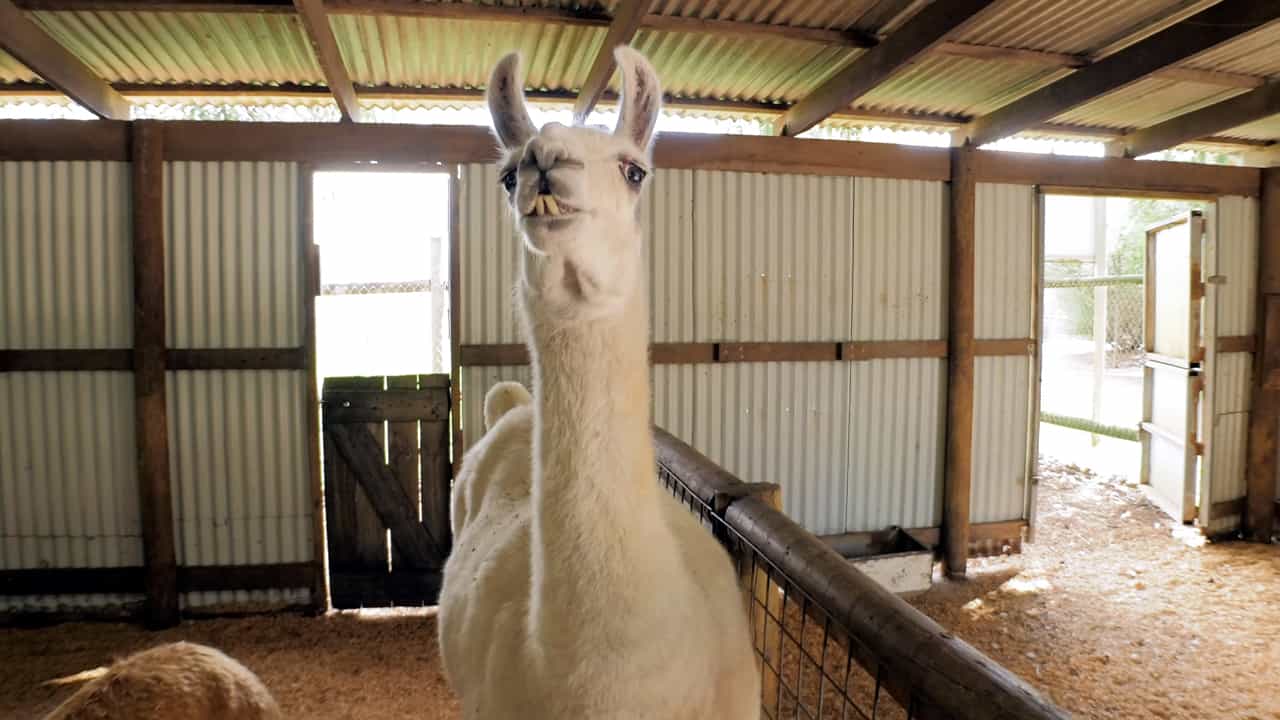Llama & Small Animals Caversham Wildlife Park Australia
Loading Video...
Llama & Small Animals Caversham Wildlife Park Australia
Llamas are a domesticated species of South American camelid, along with camels and alpacas. Llamas originated from the central plains of North America about 40 million years ago and migrated to South America about 30 million years ago. They are very social and intelligent animals, living 20-30 years, growing to an average height of 1.75 meters, and can weigh 130-200 kilograms. Llamas are very quiet animals using humming as their primary means of vocal expression. Llamas have many uses in society today including; fleece, guarding of stock, therapy, load carriers, and family pets. Llamas have a very long gestation period, between 335 and 360 days (a year!), with baby llamas called crias. A common question is; “Do llamas spit?” – Usually llamas spit to tell another llama to get out of their space or food. A bred female will spit at males who are trying to approach her, and some llamas will spit at others getting too close to their crias. Rarely will llamas spit at their owners. If they do, it is usually in fear or pain and often means the handler is at fault. Spitting at humans is the exception, not the rule.
Caversham Wildlife Park
introduces visitors to the unique selection of wildlife in Western Australia, from iconic native species to farm animals and rich birdlife.
Llama & Small Animals Caversham Wildlife Park Australia
Llama Facts
Most herds of llamas are maintained by the Indians of Bolivia, Peru, Ecuador, Chile, and Argentina. The llama is primarily a pack animal but is also used as a source of food, wool, hides, tallow for candles, and dried dung for fuel. The largest of the lamoids, it averages 120 cm -47 inches at the shoulder. A 113-kilogram 250-pound llama can carry a load of 45–60 kg and average 25 to 30 km -15 to 20 miles travel a day.
Llamas are normally sheared every two years, each yielding about 3–3.5 kg of fibre. Llama fleece consists of the coarse guard hairs of the protective outer coat it’s about 20 percent and the short, crimped wavy fibre of the insulating undercoat.
About Caversham Wildlife Park
David and Pat own and operate Caversham Wildlife Park with their son David & daughter Debbie.
When they purchased the park in 1988, the park housed a small collection of animals and birds on a modest 5 acre (2ha) property. A few years later, the park doubled in size, when the family purchased the adjoining property and the collection started to boom. In May 2003, the family designed and built a new park in Whiteman Park, once again, more than doubling in size.
Opening Hours of Caversham Wildlife Park
Caversham Wildlife Park is open 9.00am to 5.30pm every day of the year except Christmas day (December 25).
Last entry into the park is at 4.30pm.
We recommend you arrive before 3.00pm if you wish to see and do everything (some attractions start to close from 3.00pm).
To make the most of your visit and enjoy all of the attractions, we recommend you allow at least 3 hours in the park.
Monday 9.00am – 5.30pm
Tuesday 9.00am – 5.30pm
Wednesday 9.00am – 5.30pm
Thursday 9.00am – 5.30pm
Friday 9.00am – 5.30pm
Saturday 9.00am – 5.30pm
Sunday 9.00am to 5.30pm
Come and spend the day at one of Perth’s most exciting tourist attractions, showcasing the largest private collection of native wildlife in Western Australia.
Hand-feed the kangaroos, join in the interactive farm show, touch a possum or lizard, meet a wombat, watch the cheeky penguins being fed, and have photos taken with koalas! Caversham Wildlife Park; a great Australian meet & greet experience for the whole family, in one fantastic day!
All of our shows, interactive experiences, photo opportunities and animal food are included in the entry fee! With no extra money needed around the park, you can make the most of your experience at Caversham Wildlife Park.
Caversham Wildlife Park is very proudly owned and operated by a Western Australian family. We don’t receive any Government assistance; the park is solely funded by visiting patrons! Thank you for your support and assistance!

0 Comments Be First to Comment